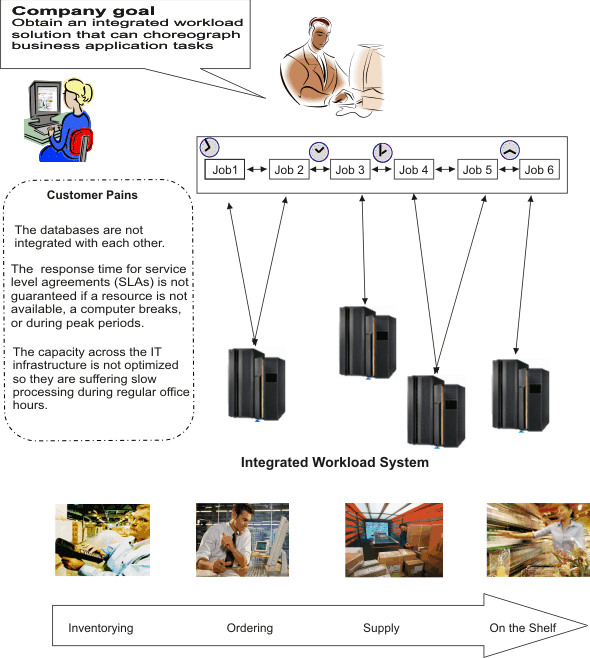The challenge
- The process as a whole is onerous and prone to error.
- The interfaces between phases are slow and not very efficient.
The company realizes it needs to better integrate with the distribution centers because processing is extremely low during the regular office hours in the warmer seasons and during holidays. Users experience applications freezing, often taking considerable time before being available for them to use again. This lack of integration is causing problems for the organization in terms of lost productivity, while applications come back online. This is a problem because the interruption of important processing is not acceptable when the company wants to expand the business. The response time for service level agreements (SLAs) must continue to be met if a resource goes down, a workstation breaks, or there is urgency for maintenance, and even more during peak periods even if the resources are geographically distributed. On the other hand the company does not want to buy new IT resources (hardware, software, applications) because this would not be used during the other periods of the year.
- Integrates the data behind their processing workflow from inventory to distribution. This makes it possible to automatically trigger the daily operations without much need for human intervention. It also gives Fine Cola complete control over the entire business process, reducing human intervention only to exception handling.
- Integrates external data coming from third parties, such as selected customers and raw material suppliers, into their process flow. Such data is provided to Fine Cola in several formats and from different applications and should be integrated into Fine Cola's databases in a seamless manner.
- Enables daily backups of their data as well as subsequent reorganization of the DB2® database with as little impact as possible on their processes. Processing of data collected online during the previous day is the next step.
- Optimizes capacity across the IT infrastructure and runs a high workload, much more than before, using shared resources, even if the resources are geographically distributed.
- Ensures 24x7x365 availability of critical business services. Disaster recovery plans are no longer sufficient because the business requires recovery within a couple of hours, not days. Recovering from last night tapes and recapturing lost transactions after a system or application failure is no longer a viable option for the company in a highly competitive market.
- Has very low probability of failure leading to maximum system reliability.
The main company goal at this time is to obtain an integrated workload solution that can entirely choreograph its business application tasks. This means solutions that optimize capacity across the IT infrastructure and run a tremendous workload, much more than before, using less resources. For example, if the company has a problem and a primary server does not process the workload, the company wants to automate the quick redistribution of system resources to process workloads and scale up or down for flawless execution. In this way the company reduces costs because it speeds recovery time, no matter what the source. The goal is to have a view of the best available resources across this dynamically shifting cross-enterprise pool.
